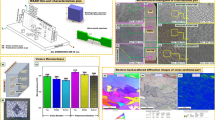Abstract
Nanoscale machinability and subsurface damage induced by chemical mechanical polishing of three kinds of single crystals were investigated by nanoscratch and high-resolution transmission electron microscope (HRTEM). When the constant loads increase from 800 μN to 3,200 μN, the friction coefficient adjacently linearly increases from 0.199 to 0.292, due to the surface machining hardening effect. As the slight wiping on the surface of Cd0.9Zn0.1Te (111) leads to microscratches, the surface turns worse, resulting in the decrease and fluctuation of friction coefficient. Shear band appears on the surface of Cd0.96Zn0.04Te (111), while it disappears on the surfaces of Cd0.96Zn0.04Te (110) and Cd0.9Zn0.1Te (111), replacing with more obvious plastic flow pile-up, and showing the better nanoscale machinability. The cross-sectional HRTEM images show that after CMP the damage layer is 2 nm, and only consists of amorphous state, indicating the main material removal mode of chemical dissolving. While after lapping and mechanical polishing, wear track with width of about 50 nm is still left on the machined surface, and subsurface damage layer is about 10 nm.
Similar content being viewed by others
References
Zhang ZY, Guo DM, Kang RK, Gao H, Li Y (2008) Chemical mechanical polishing research of CdZnTe functional crystalline with soft brittle nature. Chin J Mech Eng 44(12):215–220 in Chinese
Zhang ZY, Gao H, Jie WQ, Guo DM, Kang RK, Li Y (2008) Chemical mechanical polishing and nanomechanics of semiconductor CdZnTe single crystals. Semicond Sci Technol 23(10):105023
Jeong HD, Park KH, Cho KK (2007) CMP pad break-in time reduction in silicon wafer polishing. CIRP Ann Manuf Technol 56(1):357–360
Zong WJ, Sun T, Li D, Cheng K, Liang YC (2008) XPS analysis of the groove wearing marks on flank face of diamond tool in nanometric cutting of silicon wafer. Int J Mach Tools Manuf 48(15):1678–1687
Yang B, Shen X, Lei S (2009) Mechanisms of edge chipping in laser-assisted milling of silicon nitride ceramics. Int J Mach Tools Manuf 49(3–4):344–350
Agarwal S, Rao PV (2008) Experimental investigation of surface/subsurface damage formation and material removal mechanisms in SiC grinding. Int J Mach Tools Manuf 48(6):698–710
Jirapattarasilp K, Rukijkanpanich J (2007) The experiment of high-speed grinding of a gemstone: cubic zirconia. Int J Adv Manuf Technol 33(11–12):1136–1142
Chen JY, Huang H, Xu XP (2009) An experimental study on the grinding of alumina with a monolayer brazed diamond wheel. Int J Adv Manuf Technol 41(1–2):16–23
Wang GJ, Wang MT, Yang FC, Huang ML, Loh KN, Chen J (2009) Grey forecasting run-to-run control system in copper chemical mechanical polishing. Int J Adv Manuf Technol 41(1–2):48–56
Lin ZC, Chen ZD, Huang JC (2007) Establishment of a cutting force model and study of the stress-strain distribution in nano-scale copper material orthogonal cutting. Int J Adv Manuf Technol 33(5–6):425–435
Chandrashekar T, Muralidhara MK, Kashyap KT, Rao PR (2009) Effect of growth restricting factor on grain refinement of aluminum alloys. Int J Adv Manuf Technol 40(3–4):234–241
Tsao CC (2009) Grey-Taguchi method to optimize the milling parameters of aluminum alloy. Int J Adv Manuf Technol 40(1–2):41–48
Schlesinger TE, Toney JE, Yoon H, Lee EY, Brunett BA, Franks L, James RB (2001) Cadmium zinc telluride and its use as a nuclear radiation detector material. Mater Sci Eng R Rep 32(4–5):103–189
Vahdati M, Shokuhfar A (2008) A trend toward abrasive nano finishing of plane surfaces with magnetic field energy. Mater wis Werkstofftech 39(2):167–170
Park JW, Lee CM, Choi SC, Kim YW, Lee DW (2008) Surface patterning for brittle amorphous material using nanoindenter-based mechanochemical nanofabrication. Nanotechnology 19(8):085301
Lu YF (2005) Laser-assisted nanoscale material processing. ASME Heat Transf Div Publ HTD 376HTD(2):1025-1034
Li XP, He T, Rahman M (2005) Tool wear characteristics and their effects on nanoscale ductile mode cutting of silicon wafer. Wear 259(Part 2 Sp):1207–1214
Guo DM, Zhang ZY, Kang RK, Gao H (2009) Nanocutting process of CdZnTe single crystals. Mater Manuf Process 24(4):504–508
Author information
Authors and Affiliations
Corresponding author
Rights and permissions
About this article
Cite this article
Zhang, Z., Meng, Y., Guo, D. et al. Nanoscale machinability and subsurface damage machined by CMP of soft-brittle CdZnTe crystals. Int J Adv Manuf Technol 47, 1105–1112 (2010). https://doi.org/10.1007/s00170-009-2225-2
Received:
Accepted:
Published:
Issue Date:
DOI: https://doi.org/10.1007/s00170-009-2225-2




